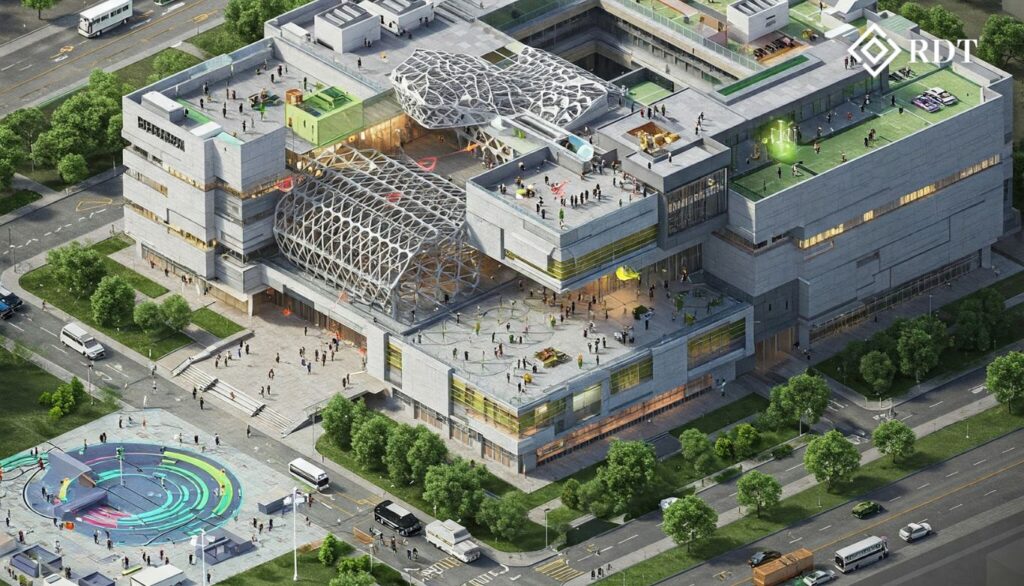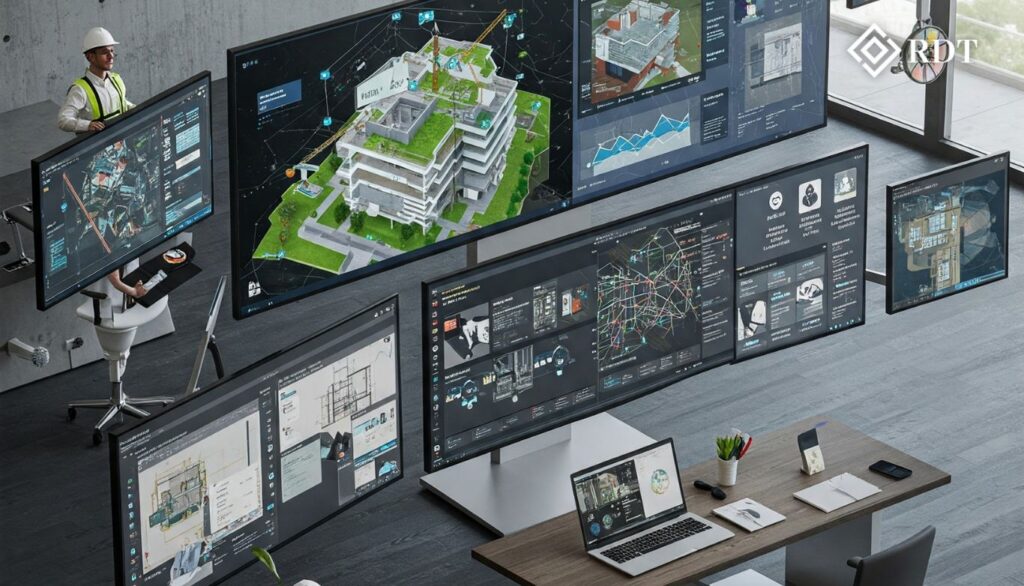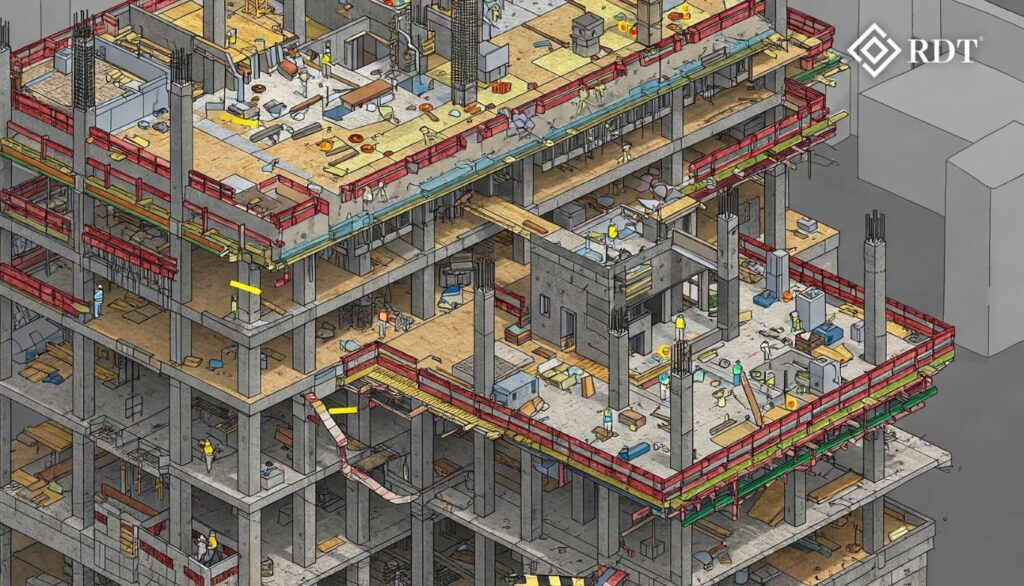In the contemporary landscape of large-scale commercial architecture, the role of Building Information Modeling (BIM) has shifted from simple 3D modeling to a hyper-integrated, AI-driven decision-making framework. For enterprise-level architects and construction managers, BIM now serves as a central nervous system that interlinks real-time design optimization, multi-dimensional simulations, predictive analysis, and lifecycle management.
This article explores how BIM-enabled environments are revolutionizing the commercial sector — reshaping how complex projects are conceived, executed, and managed.
1. Multi-Dimensional BIM Beyond Design – 5D, 6D, and 7D
While traditional BIM was predominantly concerned with spatial modeling, the latest advancements in 5D, 6D, and 7D BIM offer enterprise-level stakeholders granular insights into every aspect of a project. These dimensions are critical for time, cost, sustainability, and asset management.
5D BIM – Real-Time Cost & Time Simulation
- AI-Powered Cost Estimation: Predictive algorithms analyze historical data and material price fluctuations to generate accurate cost projections.
- Scenario-Based Budget Forecasting: Through Monte Carlo simulations, architects visualize cost variances in different design scenarios.
- Dynamic Scheduling with 4D Integration: Real-time progress tracking integrates with Gantt charts, offering predictive timeline adjustments.
6D BIM – Sustainability and Energy Modeling
- Energy Simulation Algorithms: Tools like IES VE and EnergyPlus perform real-time energy consumption analysis. Predictive AI adjusts HVAC models and recommends glazing and shading strategies.
- Carbon Lifecycle Assessments (LCA): Advanced LCA simulations evaluate embodied and operational carbon footprints. Machine learning algorithms suggest sustainable material alternatives.
- Net-Zero Design Modeling: 6D BIM systems simulate the integration of renewable energy systems, adjusting PV array placement and battery storage sizing for optimal efficiency.
7D BIM – Asset Lifecycle Management
- Predictive Maintenance AI: Sensor-integrated Digital Twins monitor MEP systems, using AI to detect anomalies and forecast maintenance needs.
- Facilities Management Integration: Enterprise-level clients access real-time data through BIM-integrated CAFM platforms for space utilization, resource allocation, and energy management.
- Lifecycle Cost Optimization: AI algorithms predict component deterioration rates, allowing architects to recommend long-term OPEX (Operational Expenditure) reduction strategies.
By implementing multi-dimensional BIM solutions, firms can reduce cost overruns, accelerate project timelines, and ensure sustainable operations.
2. Parametric and Computational Design in BIM

In large-scale commercial projects, computational design algorithms extend far beyond parametric facade generation. Through BIM-integrated generative design engines, architects manipulate design variables to arrive at the most optimized forms and functional layouts.
Algorithmic Design Generation
- Genetic Algorithms (GA): Machine learning-driven genetic algorithms optimize design alternatives based on structural loads, material efficiency, and thermal comfort.
- Topology Optimization: Finite element analysis (FEA) tools within BIM refine structural geometry, eliminating unnecessary material while maintaining structural integrity.
- Rule-Based Generative Design: Dynamo or Grasshopper scripts apply rule-based constraints for real-time facade, floor plate, and core optimization.
Multivariate Scenario Analysis
- Agent-Based Simulations: BIM platforms integrate with ABM engines to simulate occupant movement patterns, testing various evacuation or flow scenarios.
- Thermal Performance Validation: CFD (Computational Fluid Dynamics) simulations provide precise temperature and airflow predictions, ensuring occupant comfort and energy efficiency.
- Acoustic Modeling: Real-time acoustic analysis algorithms embedded in BIM environments simulate sound reflections and diffusion across large commercial spaces.
By employing parametric design tools, architects can automate complexity, optimize material use, and ensure both structural and environmental performance.
3. Digital Twins and Real-Time Operational Intelligence
Digital Twins, an extension of BIM, act as virtual replicas of physical spaces, equipped with continuous data feedback from IoT sensors. In commercial architecture, they bridge the gap between construction and operations, providing actionable insights across the building’s lifecycle.
Real-Time Data Integration
- IoT Sensor Networks: Sensors embedded in HVAC, lighting, and security systems transmit live data to Digital Twins. AI algorithms analyze this data to optimize system performance.
- Predictive Performance Modeling: Real-time operational data feeds predictive simulations, forecasting system failures before they occur.
- Automated Space Optimization: AI identifies underutilized areas and suggests adaptive layout changes to maximize space efficiency.
Facility Management and Asset Optimization
- Energy Optimization Algorithms: Digital Twins continuously compare energy consumption against simulated benchmarks, suggesting HVAC adjustments to minimize waste.
- Anomaly Detection AI: Machine learning algorithms predict mechanical or structural failures by identifying deviations from expected performance.
- Lifecycle Data Traceability: Each asset’s maintenance history is stored in the Digital Twin, ensuring transparency in decision-making for asset managers.
Digital Twin solutions are integral for maintaining operational resilience in large-scale commercial buildings.
4. AI-Powered Collaborative Design and VDC

The use of Virtual Design and Construction (VDC) within BIM has revolutionized how interdisciplinary teams collaborate on large-scale projects. AI-powered VDC platforms provide real-time clash detection, automated design conflict resolution, and predictive project simulations.
AI-Enhanced Clash Detection
- Machine Learning Conflict Resolution: AI algorithms within BIM platforms predict and resolve MEP, structural, and architectural clashes before they impact construction timelines.
- Probabilistic Clash Prevention: Predictive AI evaluates design changes in real time, forecasting the likelihood of future conflicts.
- Constraint-Based Optimization: VDC systems generate alternative solutions by simulating different clash-free scenarios.
Cloud-Based Collaborative Workflows
- Federated Model Integration: Enterprise stakeholders across geographies access a singular federated BIM modelfor real-time collaboration.
- Blockchain for Data Integrity: Decentralized ledgers within BIM platforms ensure traceability of design decisions and accountability across teams.
- AI-Driven Design Proposals: AI co-design assistants analyze design intent, regulations, and historical data to generate optimized design alternatives.
Using AI-enhanced BIM platforms, architects and contractors mitigate risks, reduce rework, and ensure project delivery within timelines.
5. Sustainable Design with AI-Powered BIM

Sustainability is no longer a passive design consideration; it is now a data-driven, AI-optimized process. Advanced BIM platforms incorporate climate data, material performance benchmarks, and operational energy simulations to ensure long-term building performance.
Climate-Responsive Design Modeling
- AI-Powered Climate Analysis: AI algorithms analyze site-specific climate data, recommending optimal building orientation and envelope design.
- Solar and Wind Simulations: Computational fluid dynamics tools predict solar heat gains and natural ventilation potential.
- Material Selection Algorithms: Machine learning evaluates material carbon footprints and embodied energy to ensure carbon-neutral designs.
Post-Occupancy Sustainability Management
- AI-Driven Building Management Systems (BMS): Continuous data from sensors enables predictive energy management and waste reduction.
- Water Conservation Models: BIM-integrated simulations optimize greywater recycling and rainwater harvesting.
- End-of-Life Material Circularity: AI-driven lifecycle assessment models suggest material reuse or recycling pathways.
Through AI-enhanced BIM sustainability modules, commercial architects ensure compliance with LEED, BREEAM, and WELL standards.
Conclusion
From real-time cost prediction and clash-free VDC workflows to Digital Twin-enabled operational intelligence, BIMhas become an indispensable tool in large-scale commercial architecture. With AI-powered BIM solutions, architects and enterprise-level stakeholders can deliver resilient, adaptive, and sustainable projects — unlocking unprecedented design efficiencies.





